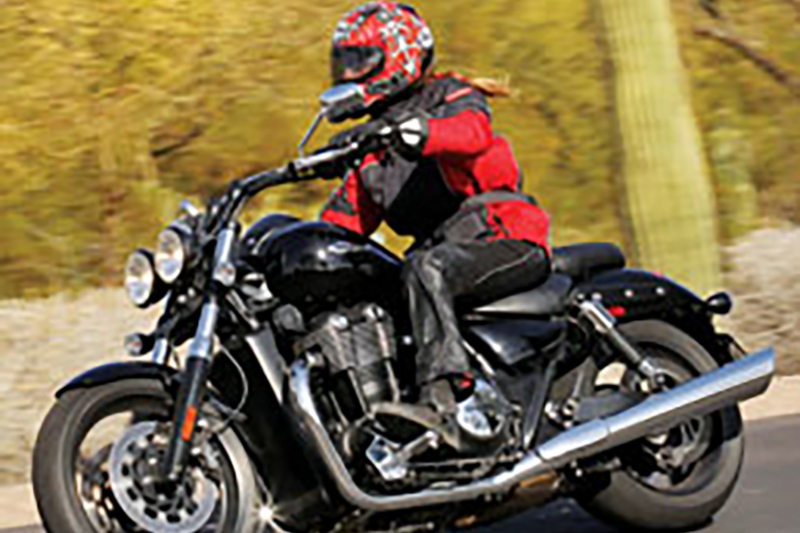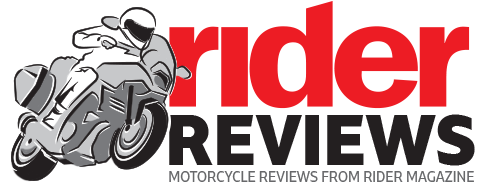2011 Triumph Thunderbird Storm

Road Test Review
Except for a couple of small entry-level bikes from other makers, the parallel twins in Triumph’s cruisers make them unique among the current parade of V-twins. At 1,597cc, the engine in its big Thunderbird was also the world’s largest production parallel-twin. Was? For 2011 the U.K.-based company has pulled out the stops and made the Thunderbird’s formerly optional big-bore kit standard equipment in its new blacked-out Thunderbird Storm. This increases cylinder bore from 103.8mm to 107.1, adding 102cc to the powerplant for a ground-pounding total of 1,699cc. Triumph explains that it wanted to create a “carbon copy” of the cultured Thunderbird, albeit one with a more aggressive attitude that it’s betting will appeal to younger riders. So now there’s a choice of nice or naughty, with the mellower standard Thunderbird the calm before the Storm, so to speak.
The $13,899 Storm is otherwise based upon the $12,499 Thunderbird and its liquid-cooled, fuel-injected, DOHC engine with six-speed transmission and belt final drive. Claimed horsepower at the Storm’s 270-degree crank is upped to 97 from 85, and the Storm has larger pistons and piston rings, revised camshafts, new cylinder liners and gaskets. On the Jett Tuning Dynojet dyno it cranked out 82.9 horsepower at 5,300 rpm and 101 lb-ft of torque at 3,000, about a 10 percent improvement over our November 2009 Thunderbird test bike. We did hear a bit of what sounded like piston slap under hard throttle after several dyno runs, a noise we’ve noticed in a few super-sized twins now.
The black Storm gets the popular all-over dark treatment with blacked-out wheels, fork lowers, most of its covers, brake calipers, shock springs and even the risers on its new handlebar. It also has distinctive twin headlamps like the infamous Speed and Street Triples, housed in black, of course, instead of chrome like the Thunderbird’s single beam.
The arrow-straight lanes of Interstate 10 between Phoenix and Los Angeles aren’t exactly the crème de la crème of motorcycle roads, but those 443 miles home from the Storm’s introduction, plus many on the Apache Trail and in Arizona’s Yavapai Indian Reservation and Tonto National Forest, made for an excellent test. My initial impression as I lifted the Storm off its sidestand was that this is one hefty cruiser. That’s partly due to its 745-pound wet weight, and also how its wide 5.8-gallon tank splays your knees out. With my longish legs I found the forward-mounted footpegs well placed (though they angle my heels downward), and that the drag-style bar keeps my shoulders relaxed and provides good leverage for pushing into turns.
With footpeg ticklers just 8.75 inches off the pavement, you’ll run out of cornering clearance before the Storm runs out of steam. Moseying along past a 1890s ghost town with tall saguaro cacti on either side of the road, when I came to a series of tight turns my heel and foot were swept off the peg the first time I dove into a corner. There’s a lot of pull at low rpm, with no shortage of torque to power the Storm strongly out of slow-speed uphill turns. The bike’s stable feel and low center of gravity inspire confidence, as do the Metzeler Marathons that roll nicely over uneven pavement and stick well. The Storm’s 200-series rear tire, 63.5-inch wheelbase and 32-degree fork rake require some effort to change direction in tight turns, yet the bike can still be hustled along at a good pace. As a lightweight I was bounced around by the bike’s stiff suspension on this road and frequently had to shift my rump back into place. The wide, dished seat doesn’t allow for a whole lot of fore- and-aft movement, though I was never crammed into the tank. The nonadjustable Showa fork has 4.7 inches of travel, and the Storm’s twin shocks have 3.7 inches and are five-position adjustable for preload only.
In the twisty sections a light tap on the brake pedal got the bike to slow smoothly. The dual front discs with four-piston calipers have good bite and stop the heavy bike quickly. Though the Storm doesn’t have ABS, Triumph says it will be an option on 2012 models. The bike has a six-speed transmission and is probably one of the best-shifting cruisers I’ve ridden. The reach to both the clutch and brake levers is a stretch for me, though, and neither is adjustable.
Triumph offers about 100 accessories for the Storm, including a windscreen, which would have been fantastic for the straight shot home. The rider’s seat has a nice step in back that provides some welcome lumbar support, and the seating position is such that the rider is supported against the wind. Even so, heading into the desert gusts along Interstate 10 I had to lean forward and hunker down on the tank to keep my helmet from smashing into my face. The Storm is a bit of a contradiction: It’s big, but at the same time its rider-friendly ergonomics are more compact than expected. Passengers will find the pillion rather high—I took a brief ride on back with another journalist, and I could rest my chin on top of his helmet if I sat up straight (and he’s only about an inch shorter than me).
Somewhere after mile 230 on the highway, a magical moment occurred between my seat and the Storm’s. Initially, the firm saddle seemed like it could use more padding, but after many miles the sturdiness was welcome. And the suspension, which was out of sorts on bumpy, twisty roads, was now doing a great job soaking up the occasional pothole, save for one mother of all potholes when my lower back took the impact. Vibration is minimal in the grips, pegs and seat, and only buzzes the mirrors slightly.
Reading the tank-mounted instruments takes a slight downward tilt of my head while wearing a full-face helmet. The tach is tiny and hard to read while riding in daylight, though at night, the needle for it and the speedo stand out like red Glow Sticks. There’s a handy digital countdown to empty on the LCD readout, too.
Welcome back to L.A.—traffic is at a standstill. It was slow going as I split lanes for the good part of 30 miles and stopped 26 miles short of my goal. When I left the bike parked outside at a restaurant, it occurred to me that Triumph must think nobody is going to mess with the bad ol’ Storm because the fuel cap doesn’t lock (an accessory locking one is $59.99). The steering lock is down on the side of the steering head and takes a separate key, too. Both front and rear seats bolt on—the “toolkit” comprises an Allen key under a side cover you use to remove the rear seat, under which lives the shock preload spanner—two tools total. Valve stems are angled to make getting at them with a pressure gauge easier, especially around the belt drive’s big rear sprocket. With the bump up in displacement came a possible bump down in fuel economy—while our Thunderbird test bike delivered 42 mpg average, the Storm could only manage 36.4 on the required premium fuel.
I’m a bit older than the “younger crowd” to whom Triumph is marketing the Thunderbird Storm, but that doesn’t keep me from being truly impressed with it. The low parallel-twin rumble from its pipes demands respect and promises genuine power, handling and comfort in a big, unique cruiser, unlike a noisy thunderclap heralding just another V-twin. Like an actual approaching storm, it’s a thing of dark beauty that’s hard not to respect.
Also making cameo appearances at the Storm’s introduction were the 2011 Speedmaster and America, which have been significantly updated to improve rider ergonomics. These 865cc parallel twin cruisers share the same five-speed, air-cooled, DOHC, fuel-injected engine, as well as the same chassis, suspension and brakes. Claimed ready-to-ride weight is 550 pounds, and they have 5.1-gallon fuel tanks. Seat heights have been lowered 1.18 inches to 27.16 inches, and rider foot controls have been moved back 1.53 inches and down 1.06 inches to appeal to beginning riders and those less confident. Sidestands have been moved back 7.48 inches, and even their lean angles have been reduced for physically smaller riders, making them easier to lift off the sidestands.
The Speedmaster is especially beginning-rider friendly, with Triumph pushing to make female riders notice. Hand controls are wider and higher and have been moved back more than 3.50 inches, and it gets a new handlebar with black bar risers. The Speedmaster’s hot-rod styling comprises a blacked-out engine and fork tubes, minimalist fenders, a slightly shorter wheelbase and longer trail (6.61 inches vs. the America’s 6.10). Up front wheel size is upped to 19 from 18 inches and the bike has just a single front-disc brake now for a cleaner look.
The America has classic cruiser styling with valanced fenders and more chrome, including the risers on the new handlebar. The seat has been changed from a two-piece to a single, and the rider sits closer to the tank. Passenger ergonomics have been improved, too, so that you won’t slide around on the seat. I was able to get a few miles on the accessorized America and the windscreen and floorboards turned this already comfortable cruiser into one that seems like it’d be a pleasure to ride all day. Triumph also offers a new line of accessories for these cruisers.
Both the Speedmaster and America offer relaxed, upright seating positions, and even though Triumph’s goal was to make them better entry-level motorcycles, they have enough appeal to keep skilled riders content on one—or both—of these saddles for years to come.
